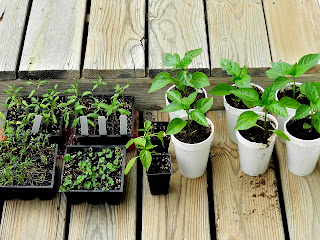 |
Tomatoes and peppers protected by tunnel covers.
(click to enlarge) |
How many others around Greenville had a freeze or frost last week? Thursday morning dawned in the 20's F at our place, six weeks after the last local frost! Instead of water, the garden hose produced icy slush. Following that hard freeze, we had a good frost on Friday morning. Our location at 934 ft. elevation almost always gets a frost if area temperatures are forecast to dip below 40 F. We were warned, however, and prepared by covering our frost-sensitive tomatoes and peppers with tunnel covers Tuesday evening until Saturday morning. They did a great job keeping damaging temperatures out; plants continued to grow inside their cozy greenhouse as if nothing happened.
 |
| Spring peas after the freeze. |
Neither freeze lasted long enough to damage trees or other foliage. We did see frostbite damage on the dill and peas, but it is limited to leaf edges; they should fully recover. We'll give them a nitrogen boost from compost tea. We sure are glad we haven't planted frost-sensitive beans, melons, and cucumbers yet. The original planting dates we had set on the calendar for those crops is April 26-27, but we may move that up a week since warm temperatures seem to be back.
The funniest thing about the late freeze? Patches of bermuda grass in the yard decided to go dormant again!
 |
| Rose and herb border was not affected by the cold. |
We pulled some of the crop of raddishes, continue to pick spinach, planted some late-season carrots, and re-tilled the corn patch. Some of the potatoes we missed last fall are sprouting, as are myriad sunflowers from seeds the birds pecked out. Gardening the second season is more fun because of bonus plants that sprout from last season's discarded vegetables.
 |
| One of many peaches developing on our trees. |
Our fruit trees were in their third year last summer and were still growing up. They have set fruit for the first time this year - at least a dozen or more peaches per tree, and the same with the apples. At least 10 of the 13 blueberry bushes are fruiting this season; and raspberries in red, purple, and black are flowering now. Everbearing strawberry plants, set a month ago, are sending out flower stems that need to be picked off until July.


















